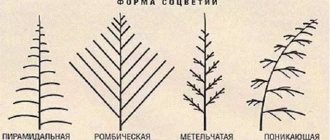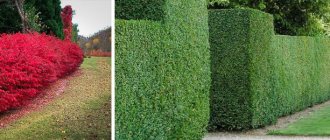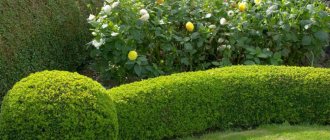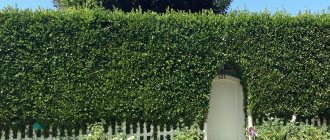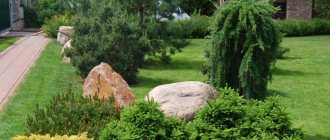The desire to fence off your territory in order to hide from indiscreet glances, uninvited guests, stray animals or to block the wind is inherent in most land owners. One of the most successful options is a hedge of green spaces. It not only protects from unwanted guests, extraneous noise and road dust, but also decorates the area. Due to its properties, cotoneaster is used as a hedge and has been used for a long time. This shrub forms a dense and beautiful screen of medium height, providing good protection and not requiring much care.
Description of cotoneaster
Wild cotoneaster brilliant grows in the northern provinces of China and southern Siberia. It loves rocky slopes and pebble deposits along river banks. The plant is very unpretentious, so dogwood bushes are convenient to use for hedges.
Cotoneaster bushes can create a hedge three meters high. The crown of a free-standing bush can exceed its height by one and a half times, so the hedge will have to be trimmed regularly.
The shiny, dark green has a yellowish underside and changes color to reddish brown in the fall. In late spring or early summer, the brilliant cotoneaster is covered with pink inflorescences. They envelop the shoots so thickly that the foliage is almost invisible because of them. In mid-autumn, shiny fruits with a diameter of 7-9 cm ripen.
Varieties of brilliant cotoneaster suitable for hedges:
Common cotoneaster. The most frost-resistant and undemanding variety. Suitable for central Russia.
Hybrid Coral handsome. A low-growing shrub up to half a meter in height and two to three times as wide. It is distinguished by white inflorescences and coral-colored berries.
Black cotoneaster. Grows up to 2.5 m, has matte foliage. Withstands low temperatures well.
Evergreen cotoneaster. Grows up to 2 m in height. The foliage is silver-green, the berries are orange, with crimson tints.
There are several low-growing varieties that should not be used to create a hedge: creeping cotoneaster, horizontal, creeping, appressed, dwarf. These types are more suitable for decorative borders or lawn design.
Important! Dogwood differs from brilliant cotoneaster. The berries of the first type are used for food, while the second type is inedible.
Dogwood - ornamental and fruit shrub
Dogwood is widespread wherever it is warm and sunny. It can often be found in Asia, some European countries, Africa, and the Black Sea regions.
Dogwood
In Russia, the deciduous, tree-like dogwood shrub mainly grows. Gardeners cultivate it for its exceptional decorative foliage and flowers. The stems with wine-red or bright yellow bark are interesting. It is also valued for its beneficial fruits.
Origin and appearance of the fruit bush
The province of British Columbia is rightfully considered the birthplace of the dogwood. It even became its official flower, as well as the states of Virginia and Missouri (USA).
The most widespread in these territories is the common dogwood (male). The dogwood bush grows up to 2-3 meters in height. Red-red weeping shoots give it a unique beauty.
Interesting! The stems in contact with the surface of the earth immediately begin to take root.
The leaves can be arranged oppositely or alternately. The color of the leaf blade is dense green. The bush lends itself well to crown formation. By the way, it can be shaped like a tree.
Dogwood tree or shrub belongs to the group of long-livers. Once planted, you can admire the beauty and receive healthy berries for many generations, since dogwood trees grow in one place for about 200 years. By the age of 20, maximum fruiting is achieved - about 80 kg.
Description of dogwood flowers and fruits
Dogwood begins to bloom in early May. The buds are small, milky white, collected in loose inflorescences. It takes about 2 weeks before fruit sets. Fragrant flowers are very attractive to flying insects, so pollination of the bush is almost 100%.
Dogwood berries
Single- or double-stone fruits ripen from August to October. Depending on the variety, the berries have different colors and sizes. The color of the fruit is predominantly red, but you can often find yellow, orange, purple, black, and pink berries. The fruits of hybrid forms reach up to 3 cm in length.
The shapes of the berries are also different. There are:
- cylindrical;
- pear-shaped;
- spherical.
Note! The fruits differ in taste and fullness. There are sweet, tart, juicy, densely dry
Pros and cons of cotoneaster hedges
A green fence made from brilliant cotoneaster can withstand any conditions: lack of sun and moisture, poor soil, severe air pollution near the road. Even unsuccessful pruning will only spoil the decorative effect and the nerves of the owners, but will not cause significant harm to the plant.
The brilliant cotoneaster remains decorative even in autumn. Its foliage is painted in amazingly beautiful shades of yellow, crimson, and red. And black fruits are stored until frost.
The brilliant cotoneaster blooms for a whole month. And all this time the hedge will fill the area with a pleasant aroma. True, not only people like this smell. Bees sense it from a great distance and visit the blooming cotoneaster in large numbers.
A hedge of brilliant cotoneaster has strong immunity. But still, sometimes it is attacked by pests. The brilliant cotoneaster is afraid:
- apple aphid;
- scale insect;
- cotoneaster mite;
- plum sawfly.
Insects are eliminated using herbal remedies or insecticides. The brilliant cotoneaster is susceptible to diseases of powdery mildew and fusarium. It will be necessary to disinfect the soil, completely pruning diseased shoots and burning them. After cutting off diseased areas, they are treated with a fungicide.
Fence location options
The brilliant cotoneaster loves the sun, but will grow well in a shaded place. If rapid growth of the shrub is required, you should choose places well lit by the sun. There the plant will quickly reach good shape.
A hedge of brilliant cotoneaster can be located:
- along the external boundaries of the site;
- along the paths;
- cover outbuildings from view;
- fence off a place to rest;
- complement a multi-tiered composition of flowers and creeping plants;
- serve as a shiny green border for flower beds
There are no thorns on the branches of the brilliant cotoneaster. This slightly worsens its protective functions, but reduces the risk of injury while caring for the bush. Danger can only arise during the flowering season, when the hedge will be visited en masse by bees flocking from all over the area.
How to plant brilliant cotoneaster for a hedge
You can create a hedge from brilliant cotoneaster bushes using:
- seeds;
- cuttings;
- divisions;
- layerings.
All these methods will require time, skill and hassle. Cotoneaster seeds do not germinate well. They are prepared from ripened berries. The fruits are dried in the open air, the seeds are removed and washed with water. Those seeds that float to the surface must be thrown away - these are “dummy”. Good seeds are left in water. Then they are dried, covered with a peat-sand mixture and put in the refrigerator.
It is much easier to create a green hedge using 10-15 cm cuttings. At the beginning of summer, when pruning cotoneaster, strong young branches with two “knots” are cut. If cuttings are prepared in the autumn, you can use old, already woody branches, but then the number of “nodules” is increased to three. In the spring, the cuttings are treated with a special solution to stimulate growth and planted in sandy-peaty soil to a depth of five centimeters in a greenhouse.
Layers are formed from young shoots of brilliant cotoneaster. Most often, this method is used for low-growing or creeping shrubs. You need to choose a healthy shoot, lay it on the ground and carefully secure it with a staple, hook, or wooden slingshot. The next season, carefully cut off a branch near the very base of the mother plant and replant the cuttings.
To plant brilliant cotoneaster by division, you will have to carefully dig up the bush and divide it with a knife into several separate parts. Then the resulting new plants are immediately planted in the place of the future hedge.
Calculation of the number of seedlings
The recommended gap between cotoneaster seedlings is approximately 50 cm. This is the required minimum. The maximum gap is 2 m. You can plant bushes even less frequently, but the result will bear little resemblance to a hedge. What you will get, rather, is a row of free-standing bushes.
Before determining the required number of cotoneaster seedlings, choose a place for planting and measure the length of the future hedge. Divide the result by 0.5 m. This will be the maximum number of seedlings. If the place is well lit all day, the brilliant cotoneaster will grow well. Therefore, the gap between the bushes can be safely increased, i.e., fewer seedlings will be needed.
Site and soil preparation
Before planting a hedge of brilliant cotoneaster, you need to choose the right place for it and prepare the soil. The plant loves bright sun or slightly shaded areas. There is no need to prepare the soil over the entire area of the future fence. The main soil can be anything, since the nutrient mixture is placed directly into the holes prepared for planting seedlings.
Rules for planting cotoneaster to create a hedge:
- dig a hole about half a meter deep and the same diameter;
- lay gravel or brick chips in it in a layer of about 20 cm;
- add soil from turf soil, peat, humus and sand in a ratio of 2:1:1:1;
- lower the plant into the hole;
- make sure that the root collar is level with the ground;
- dig in, compact the soil, water.
You can (but not necessarily) add more lime to the planting mixture. You will need approximately 200-300 g of lime per 1 square meter. m. of soil. After planting, a small area around the roots is sprinkled with peat to protect and enrich it with microelements.
Important! For ease of planting, the brilliant cotoneaster is planted not in separate holes, but in a trench dug at the site of the future fence of the required depth.
Disembarkation dates
With the onset of warmth, when the ground has already thawed, but buds have not yet appeared on the trees, you can begin planting seedlings. Most varieties are planted during this period, however, brilliant cotoneaster and chokeberry take root well even when planted in autumn. The period between the fall of leaves and the appearance of the first frost is considered suitable for planting in autumn.
As a rule, at the beginning of the season, ready-made, purchased seedlings grown in pots are planted. They can be planted even in summer, since the root system is already well formed and the plant can easily tolerate transplantation.
Important! When planting in late autumn, you need to complete the work as early as possible so that the brilliant cotoneaster has time to take root well before the onset of frost.
Planting scheme
If a tall and thin hedge is planned, the brilliant cotoneaster is planted in one row. To create a dense, wide border, seedlings are placed in two rows in a checkerboard pattern. In this case, there are approximately 4 seedlings per linear meter.
It is not recommended to plant a triple row of cotoneaster bushes. The middle part will be inaccessible for inspection and treatment, which can lead to damage by pests and diseases. In addition, plants in the middle of the row receive less sun (the sides are covered by nearby bushes), which can slow down the growth of the hedge.
Important! When forming a future hedge, the growth of the crown should be taken into account. The distance between cotoneaster bushes in a hedge should be from 0.5 to 2 m.
Landing Features
Almost all varieties of cotoneaster cultivated today tolerate planting well in any soil. But when transferring seedlings to open ground, it is better to wait until spring, until the snow melts and the last night frosts have passed.
What time to plant
Almost all types of such plants are recommended to be planted in open soil in the spring. In this case, you need to wait until the earth warms up well, but the buds should not yet begin to open. Also, such a shrub can be planted in autumn, but this must be done after massive leaf fall, but before frost begins. In autumn, for example, it is recommended to plant chokeberry and glossy cotoneaster. Such a plant can be safely grown in shaded areas, and it will look quite impressive. But if the shrub is planted in an open, well-lit area, it will be able to reach the peak of its decorative potential. The quality of soil for cotoneaster is not particularly important. Experienced gardeners advise pouring a suitable soil mixture directly into the planting hole.
Site selection and soil preparation
Despite the unpretentiousness of the crop, it is better to plant it in areas with good lighting. But if this is not possible, the bushes will feel great in partial shade. The main thing is that the plants are reliably protected from strong winds, and that groundwater does not lie close to the surface.
The composition and structure of the soil for the crop is not of fundamental importance. But if you want to speed up the process of establishment of the shrub, prepare a soil mixture: you will need 2 parts turf soil, 2 parts sand and 1 part compost (can be replaced with peat).
Landing rules
Cotoneaster seedlings should be placed at a distance of 2 m from each other. The root system is deepened into the planting hole by 65–70 cm. Do not forget about the drainage layer - its thickness should be at least 20 cm; crushed brick or expanded clay can be used as drainage.
Caring for a cotoneaster hedge
The plant will not require much care. The bushes will have to be trimmed to remove old and diseased branches, as well as to maintain the width of the cotoneaster hedge. You also need to loosen the root soil and water it from time to time during drought. In winter, as a rule, no care is required. You can cover the plantings with spruce branches or branches from severe frosts, but this is true for low-growing and creeping varieties.
Young cotoneaster bushes will require regular weeding and weed removal. Over time, the overgrown crowns will shade the root soil, completely blocking the sun for the weeds.
When to trim cotoneaster for hedges
A hedge of brilliant cotoneaster is pruned in the spring, before buds appear. This will not harm the plant, will rejuvenate it and allow it to form a crown of the desired configuration. The brilliant cotoneaster is not afraid of too much pruning. It can easily withstand pruning last year's shoots by a third of their growth. Pruning tools should be very sharp to do as little damage to the plant as possible.
Pruning for sanitary purposes can be done at any time. It is needed to remove dried, old or diseased branches. If young growth thickens the hedge too much, it can also be cut out with sanitary pruning.
Important! After pruning diseased branches, tools should be washed well or wiped with alcohol to prevent the transfer of infection during subsequent use.
Watering
The natural growing conditions of the brilliant cotoneaster are quite harsh. It does not require abundant watering. If the summer is quite humid, then the hedge may not need to be watered at all. If during the entire warm period not a single rain fell, then you will have to water the bush at intervals of about two weeks. Each adult bush will require 7-8 buckets of water. After rain or watering, it is necessary to check the condition of the soil around the bushes, remove all weeds and loosen it slightly to a depth of 15 cm.
As a rule, the main purpose of watering a hedge is not to moisten the soil, but to wash the foliage so that it becomes bright and shiny again. This is especially true for bushes that fence off an area from a roadway with heavy traffic. Washing your fence with a hose fitted with a shower attachment washes away dust, dirt, and grime and improves the appearance of your fence.
Important! The brilliant cotoneaster does not like too moist soil around the roots.
Top dressing
It is recommended to fertilize at the beginning of the spring season. You will need urea or any other mineral fertilizers at the rate of a tablespoon per 10 liters of water. It is optimal to feed each bush separately, watering the soil around the roots. If the planting is too dense, then you can simply apply fertilizer along the hedge, as close to the roots of the bushes as possible.
You can repeat feeding around the second decade of May, before flowering begins. You can add superphosphate (60 g per sq. m) and potassium sulfate (10 g per sq. m) to the mixture.
Reproduction
To independently propagate horizontal cotoneaster, different methods are used. The plant successfully propagates by vegetative and generative methods. With their help, you can root cotoneaster, but not all methods are equally effective.
Growing from seeds
Gardeners use this method least often. Cotoneaster seeds have poor germination. No more than 60% of the seed material produces full-fledged viable seedlings. The seeds are collected in early October after the fruits have fully ripened. To do this, separate the pulp along with the peel. Seeds are dipped in a container of water to test for germination. Those that settle to the bottom are used for planting, those that float to the surface are thrown away.
Important! Cotoneaster seeds are sown in the fall so that they spend the winter in the soil. Without natural stratification, germination rate decreases several times. The first shoots appear only at the end of May or at the beginning of June
If necessary, they are thinned out. The seedlings are left to grow in natural conditions, periodically watering and clearing the plantings of weeds. Only after 2-3 years are they transplanted to a permanent place
The first shoots appear only at the end of May or early June. If necessary, they are thinned out. The seedlings are left to grow in natural conditions, periodically watering and clearing the plantings of weeds. Only after 2-3 years are they transplanted to a permanent place.
Cuttings
This method is the most effective. Young, one-year-old shoots are used as planting material. Cuttings are cut in early June. They are soaked for 24 hours in water with the addition of a rooting stimulating drug. “Kornevin” is suitable for this purpose. Seedling boxes are filled with a mixture of equal volumes of peat and coarse sand. It is slightly moistened and the cuttings are placed at an acute angle. The top of the box is covered with film. Periodically, the cover is removed for ventilation and moisture. Rooted seedlings are transplanted to the place of permanent cultivation with the onset of spring.
How quickly does a cotoneaster hedge grow?
Building a regular fence is much faster than building a hedge. This process can be slightly accelerated by planting young, but already well-formed bushes. But they will cost much more than seedlings.
After planting, the cotoneaster bushes are left untouched for two years. Only after they have grown a little do they begin to form a hedge. The first stage is trimming to height. This will provoke rapid growth of side shoots.
Once the width of the hedge is sufficient, the growth of the sides is limited. To begin with, the shoots should be pinched to increase tillering. However, shoots that extend beyond the intended contour are cut off.
Important! Cotoneaster will give the brightest shade of autumn foliage on sandy soil. Clay soil does not contain the elements necessary for this.
